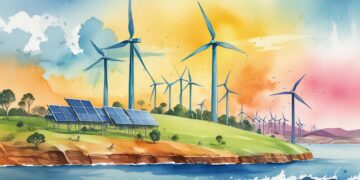Innovations in Renewable Energy: Fueling the Next Wave of Economic Expansion

Transformations in the Energy Sector
In recent years, the global emphasis on sustainability has led to a significant transformation in the energy sector. This shift towards renewable energy innovations is not only environmentally beneficial but also a powerful catalyst for economic growth. Countries around the world, including Australia, have embraced these changes, recognizing the dual advantages of sustainability and economic resilience.
Renewable Energy Technologies in Australia
Australia is a prime example of a nation tapping into various renewable energy technologies, spurred by its natural resources and favorable climate conditions. The country’s commitment to reducing carbon emissions is reflected in its investment in diverse energy solutions:
- Solar Energy: With an abundance of sunshine, Australia has become a leader in solar energy. Initiatives like the Small-scale Renewable Energy Scheme (SRES) have encouraged homeowners to install solar panels, dramatically increasing the amount of energy generated by this resource. For instance, over 3 million Aussie homes now have rooftop solar, significantly cutting electricity bills for families while contributing to carbon reduction goals.
- Wind Power: Utilizing wind turbines, particularly in regions like South Australia, wind power has played an integral role in the energy mix. By 2021, wind energy contributed to nearly 50% of the state’s electricity generation, demonstrating the viability of harnessing natural wind patterns for clean energy.
- Hydro Energy: Australia’s mountainous regions and river systems provide perfect opportunities to harness hydro energy. Large-scale projects, such as the Snowy Mountains Hydro-electric Scheme, not only produce significant electricity but also store energy, providing stability to the electricity grid.
- Geothermal Energy: Although still in its early stages compared to solar and wind, geothermal energy is being explored in regions like the Cooper Basin, where the Earth’s heat can be utilized for both electricity generation and heating, ensuring a reliable energy supply.
Benefits of Renewable Energy
The shift towards renewable energy offers a myriad of benefits that extend beyond environmental impact. Consider the following advantages:
- Job Creation: As investment in renewable energy technologies increases, new job opportunities arise in manufacturing, installation, and maintenance. The solar and wind sectors alone have created tens of thousands of jobs across Australia, providing a significant boost to local economies.
- Energy Independence: By investing in local renewable energy sources, Australia can enhance its energy independence. This reduces reliance on imported fossil fuels, which can be subject to volatile price changes and geopolitical tensions, thereby bolstering national security.
- Cost Efficiency: The costs associated with renewable energy technologies have decreased dramatically in recent years. According to the International Renewable Energy Agency (IRENA), the global average cost of solar photovoltaic technology fell by 82% between 2010 and 2019. As a result, renewable options are increasingly becoming the more economical choice for energy supply.
Conclusion
As we delve deeper into the potential of renewable energy innovations, it is evident that these technologies will play a crucial role, not just in combating climate change, but also in driving economic growth and stability within Australia. The ongoing advancements in this sector underscore a promising future where sustainable energy practices contribute to broad national prosperity.
SEE ALSO: Click here to read another article
Advantages of Embracing Renewable Technologies
The rising adoption of renewable energy technologies not only addresses environmental concerns but also provides substantial economic advantages. Leveraging these innovations can lead to transformative impacts across multiple sectors. Here are some of the key benefits:
- Local Economic Development: Investments in renewable energy frequently lead to economic development at both the local and national levels. New projects create infrastructure improvements, increase local tax revenues, and stimulate related industries. For example, a solar farm developed in rural Australia enhances infrastructure for energy distribution while also fostering job creation in construction and maintenance.
- Innovation and Competitiveness: As the demand for sustainable energy solutions grows, the renewable energy sector is ripe for innovation. Companies that embrace renewable energy technologies often find themselves becoming leaders within their industries. This pushes them to innovate further, improving efficiency and reducing costs, ultimately making them more competitive both domestically and internationally.
- Attracting Investments: The global trend towards sustainability has made renewable energy projects attractive to investors. Funds focused on socially responsible investments are eager to support innovative energy solutions. In Australia, ventures such as battery storage projects have begun to attract significant investment, allowing for further development in renewable energy infrastructure.
- Health Benefits: Transitioning to renewable energy sources can result in improved air quality and public health outcomes. By reducing reliance on fossil fuels, Australia can decrease pollution levels, which are linked to health issues such as asthma and other respiratory illnesses. This not only promotes a healthier population but can also reduce public health expenditures in the long run.
Moreover, the Australian government has recognized these various benefits, and policies are increasingly being tailored to support the growth of renewable energy sources. Initiatives such as the Renewable Energy Target (RET) aim to ensure that a significant portion of electricity comes from renewable sources, providing a framework that encourages investment and expansion in this sector. By addressing both economic and environmental imperatives, Australia sets a precedent for a sustainable future that prioritizes public welfare while also fostering economic growth.
Pioneering Projects Leading the Way
Australia has seen numerous pioneering projects emerge that showcase the integration of innovative renewable technologies. For instance, the Hornsdale Power Reserve in South Australia, one of the world’s largest lithium-ion battery installations, serves not only as a grid stabilization resource but also as a model for how renewable energy can be stored and used efficiently. This project exemplifies how technology can be optimized to meet demand more effectively, reducing reliance on traditional fossil fuel sources.
These initiatives are marks of a broader trend across Australia, where state and federal governments encourage the transition to greener energy solutions. Local communities are reaping the benefits, positioning themselves as participants in the shift towards a sustainable energy future. As these projects continue to unfold, they reflect a promising commitment to both environmental responsibility and economic vitality, ensuring that Australia stands at the forefront of the renewable energy revolution.
CHECK OUT: Click here to explore more
Emerging Technologies Transforming the Landscape
The renewable energy sector is experiencing a surge of innovation, as emerging technologies are transforming how energy is produced, stored, and consumed. The advancements being made in energy generation, storage solutions, and efficiency contribute significantly to the economic landscape while enhancing sustainability. Below are some notable innovations:
- Photovoltaic (PV) Advancements: Solar technology is continually evolving, with new materials and designs such as perovskite solar cells showing promise for higher efficiency rates and lower production costs. Innovative tools like solar tracking systems allow solar panels to follow the sun’s path, maximizing energy capture throughout the day. Australia is already home to large-scale PV installations that demonstrate these advancements, significantly increasing energy output.
- Hydrogen Production and Storage: Green hydrogen, produced using renewable energy sources, promises a versatile solution for energy storage and transport. It can be utilized directly in fuel cells to power vehicles or be blended into natural gas pipelines to reduce carbon footprints. Australia is actively investing in hydrogen projects, particularly in regions with abundant solar and wind resources, positioning itself as a potential world leader in this emerging market.
- Energy Storage Solutions: Battery technology is advancing rapidly, with lithium-ion batteries becoming more efficient and cost-effective. Innovations such as flow batteries and compressed air energy storage are rising in popularity. These technologies can store large amounts of energy generated from renewables, allowing for grid reliability and optimizing energy usage during peak demands. Projects like the Musk-backed Hornsdale Power Reserve are relevant examples showcasing how energy storage can stabilize the grid and enhance renewable energy systems.
- Smart Grids and IoT Integration: The integration of Internet of Things (IoT) technologies into energy systems allows for real-time data collection, improving energy management and distribution. Smart grids utilize these advancements to balance energy loads, reduce waste, and respond quickly to fluctuations in energy demand. In cities like Sydney, smart grid initiatives are enabling more efficient energy use and promoting consumer engagement through data transparency.
These technological advancements are not merely theoretical; they are currently being implemented in various projects across Australia, demonstrating their potential in driving economic growth. The Federal Government, alongside industry partners, has committed to a range of initiatives focused on the deployment and scaling of these innovative technologies, recognizing their critical role in Australia’s energy transition.
Workforce Development and Education
As the renewable energy sector expands, the demand for a skilled workforce capable of supporting and sustaining this progress rises concurrently. Education and vocational training programs tailored towards renewable energy technologies are vital to ensure that the workforce is well-equipped for the jobs of the future. Australia has initiated several programs focusing on renewable energy training and workforce development, addressing the skills gap in this rapidly evolving field.
Universities are also increasingly incorporating renewable energy studies into their engineering and environmental science programs, fostering a new generation of experts in sustainable energy solutions. Collaborative efforts among government, educational institutions, and industry leaders will ensure that Australia not only keeps pace with global advancements but potentially leads the way in renewable energy innovation.
In conclusion, the integration of emerging technologies, workforce development, and supportive policies is critical to harnessing the full potential of renewable energy initiatives. As these innovations continue to develop and become commonplace, they will play a pivotal role in fueling the next wave of economic expansion in Australia.
CHECK OUT: Click here to explore more
Conclusion
As we reflect on the rapid advancements within the renewable energy sector, it becomes increasingly clear that innovation is the cornerstone for fostering sustainable economic growth in Australia. The emergence of superior technologies, such as advanced solar PV systems, green hydrogen applications, improved energy storage, and smart grid solutions, not only enhances our ability to harness renewable resources but also fortifies the country’s economic framework.
Moreover, to fully capitalize on these innovations, workforce development plays a crucial role. By investing in education and training, we create a skilled workforce prepared to take on the challenges of this evolving landscape. Universities and vocational training programs are essential to bridging the skills gap and equipping students with the knowledge needed to thrive in the green economy.
As Australia commits to ambitious renewable energy targets, it is evident that strategic partnerships between government, industry, and educational institutions will be paramount. These collaborations will not only accelerate the deployment of innovative technologies but position Australia as a global leader in renewable energy solutions. By continuing to embrace these innovations, Australia can drive economic expansion while contributing to a more sustainable planet.
In conclusion, the journey towards a renewable energy future is not just a technological revolution; it is an opportunity for economic advancement, job creation, and environmental stewardship. If we work together to support these initiatives, the prospects for a flourishing and sustainable economy are not just hopeful—they’re within our grasp.

James Carter is a financial writer and consultant with expertise in economics, personal finance, and investment strategies. With years of experience helping individuals and businesses navigate complex financial decisions, James provides practical insights and analysis. His goal is to empower readers with the knowledge they need to achieve financial success.






